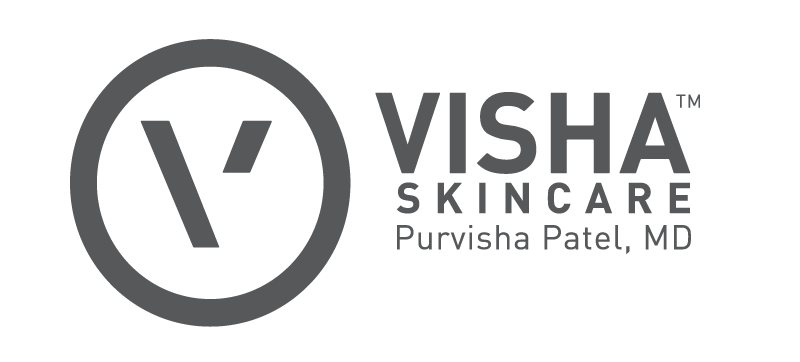
Well and Good shared "Got a rogue breakout? Try using turmeric for acne" featuring Dr. Purvisha Patel and Visha Skincare
People have been turning to turmeric for ages because of how healthy—and anti-inflammatory—it is for your diet. The ingredient is becoming a DIY beauty star for the same reason, and the ingredient is even trickling into skin-care products, thanks to its anti-inflammatory effects on the skin. Given that inflammation is at the root of breakouts, it’s no surprise than many people are turning to turmeric for acne.
If you’re not familiar, turmeric is a plant that is native to southeast Asia. “It’s commonly used as a spice. The powder comes from the roots of the turmeric plant, known as curcuma domestica, which is thought to contain medicinal properties,” says Marnie Nussbaum, MD, a board-certified dermatologist in New York City. People relate the plant to ginger, adds Purvisha Patel, MD, board-certified dermatologist and founder of Visha Skincare. “It is bright yellow because of the active ingredient curcumin,” she says.
It’s used in beauty products because of its bacteria-killing, irritation-quelling, and nourishing properties. “Curcumin is a potent anti-inflammatory, antimicrobial, anti-neoplastic, and antioxidant, as it combats free radicals and free radical damage,” says Dr. Patel (free radicals can result in the skin aging more quickly). “It has been used for centuries in Eastern medicine to combat certain skin conditions such as psoriasis, vitiligo, and acne.” Keep scrolling to learn more about how the ingredient is an acne-fighting superhero.
Using turmeric for acne
Acne is an actual inflammatory condition of your oil glands and your pores. “Acne is caused by follicular occlusion, microbial overgrowth, sebum production, and/or inflammation,” says Dr. Patel. Turmeric comes into play because, she explains, it works to decrease microbial growth (aka that bad, acne-causing bacteria), sebum production, and inflammation. And as an added bonus: “Topical turmeric also helps with discoloration or hyperpigmentation if it’s used over a long period of time,” she says.
Dr. Nussbaum points out that some studies have proven the ingredient’s efficacy in treating breakouts, though more need to be conducted to prove its conclusive benefits to the skin. “Recent clinical studies on curcumin, the active ingredient in turmeric, indicate that it’s an antioxidant and offers anti-inflammatory benefits. Think inhibiting inflammation signals in the body,” she says. “Some research suggests that curcumin, when combined with lauric acid, contains antibacterial properties that may help banish certain types of acne-causing bacteria—specifically, P. acnes.”
Turmeric isn’t going to quash all acne woes, though. Dermatologists note that it is more likely to be effective in treating mild to moderate acne, “not deeper cysts or nodules which have been present for days to weeks,” says Dr. Nussbaum. “Those will respond better to cortisone injections delivered in-office by a board-certified dermatologist.” That said, Dr. Patel says that ingesting turmeric orally—400 to 600mg per day—can help with deep cystic acne.
How to use turmeric in your skin-care routine
As is the case with many active ingredients in skin care, you’ll find all different concentrations and delivery systems of turmeric inside of beauty products. “Topical agents will vary in strength, sourcing of the ingredient, and permeability into the skin,” says Dr. Patel, who actually believes that using turmeric in a DIY paste is one of the most effective ways to go when treating acne. “It is best used directly on the skin in powdered form, mixed with water into the form of a paste,” she says, nothing that this can be an overnight spot treatment or used as a face mask.
Before you incorporate it into your regimen though, Dr. Nussbaum recommends consulting your dermatologist. “I’d discuss your acne concerns with your dermatologist, who will help guide you through the best holistic treatment plan,” she says. “Curcumin in turmeric can interact with some medications and there may be a risk of allergic reactions when applied topically. You should also avoid turmeric if you are pregnant or have issues related to blood sugar, blood clotting, stomach acid issues, or gallbladder issues.”
When you use turmeric on your skin, Dr. Patel says it’s best to use it like you would with other active ingredients: at night only. “The best time to use it is before bedtime, which will be the maximum amount of time a product can stay on your skin undisrupted, and can increase absorption as the body temperature rises overnight,” she says.
Even though turmeric can be a key acne-fighting spot treatment, derms say it’s fine to use all over your skin (even your body) too. “Just note that in its purest form, it may leave a stain, so it’s best to use on the areas that it is needed the most,” says Dr. Patel. But Dr. Nussbaum says that otherwise, it’s safe to use every single day if you’re seeing good results. Keep scrolling for turmeric-infused skin-care products to shop for your own acne-quashing routine.
